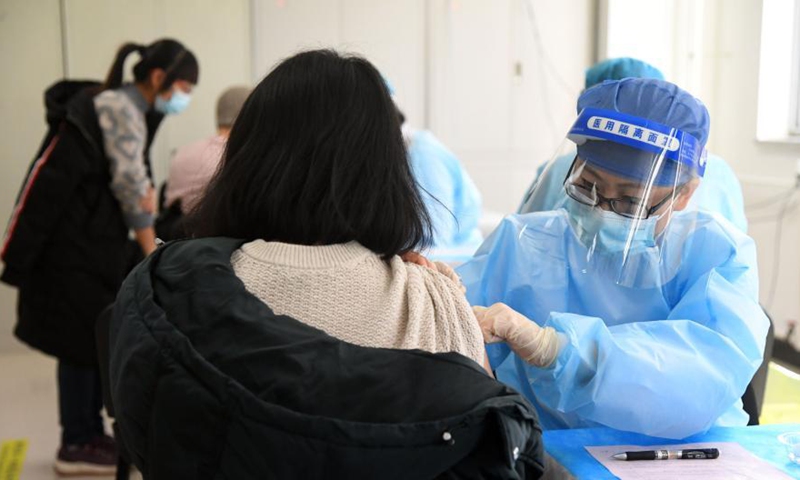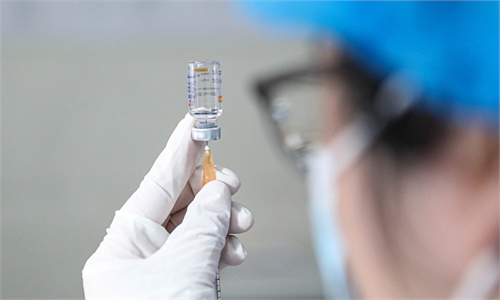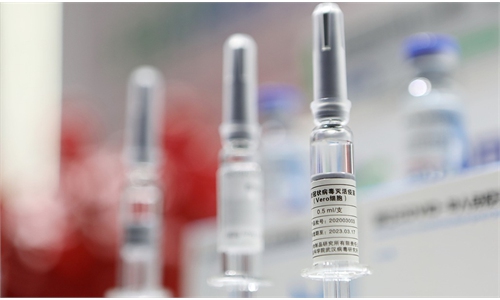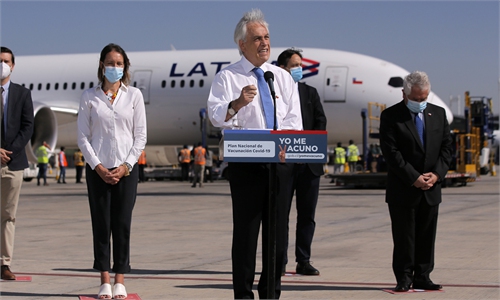China gives 24m COVID-19 doses, adverse effect rate no higher than flu shots
COVID-19 vaccines effective, adverse effect rate no higher than flu shots

A medical worker (R) inoculates a recipient with a 2nd dose of COVID-19 vaccine at a temporary vaccination site in Haidian District of Beijing, capital of China, Jan. 29, 2021. The administration of the second dose of COVID-19 vaccines for key groups of residents throughout Beijing started on Jan. 22, and is expected to conclude before Feb. 8.Photo:Xinhua
The Chinese Center for Disease Control and Prevention (CDC) on Sunday announced that the country has so far administered more than 24 million doses of COVID-19 vaccines, and the reported rate of severe adverse effects rate is no higher than flu shots.As China is facing a complicated epidemic control situation, registering 2,016 domestically transmitted COVID-19 cases in January - the highest since March 2020 - observers noted that pushing forward steadily with the vaccination program can help reduce epidemic risks.
Some Chinese authorities have said China was planning to vaccinate 50 million people before the Chinese New Year to curb the spread of the virus.
Experts noted the low adverse effect rate proved the safety of Chinese COVID-19 vaccines and should encourage more people to receive the injection. China's vaccination drive is going smoothly and orderly, and the target for immunity can be met.
China's top respiratory disease expert Zhong Nanshan on Sunday noted that the safety of inactivated vaccines, which are being administered in China, is guaranteed. The severe adverse effect rate is 1 per million while that for the flu shot is 3 per million.
Antibodies can be maintained for more than six months and many who received the shots eight months ago still have 90-percent antibody levels, Zhong said at a Sunday press conference.
Zhong also explained that multiple efficacy rates for Chinese vaccines reflect the results of phase III clinical trials in different countries, which have different standards and experimental methods. If the trial is done on medical personnel, the infection rate will be higher than on ordinary people, Zhong said.
Feng Duojia, president of the China Vaccine Industry Association, told the Global Times that with the Spring Festival approaching, the country is accelerating vaccination and more ordinary groups are receiving the shots.
This year's Spring Festival falls on February 11, and vaccination will help reduce the infection and outbreak risks during this period, given the travel rush and family reunion. This year's festival trips are expected to be 60 percent fewer than in 2019.
The Chinese mainland reported 92 domestic confirmed patients on Sunday, 91 in Northeast China's Jilin and Heilongjiang provinces and one in North China's Hebei Province, according to official data.
The recent outbreaks in Northeast China saw multiple super-spreader events including one on a train that involved five passengers who further infected their close contacts and passed on the contagion.
Amid the complicated epidemic situation, authorities have called on people to avoid travelling during the Spring Festival holidays, a traditional travel peak.
But some local governments have taken overly strict measures to prevent people returning from their work places, which have sparked controversy.
Officials said that local governments should not require returnees to undergo centralized or home quarantines, demand nucleic acid tests for non-key groups from low-risk areas, or extend the period of health monitoring.
Mi Feng, a spokesperson of the National Health Commission, noted that the domestic epidemic was an overlap of sporadic cases and regional clustered outbreaks.
New confirmed patients and asymptomatic cases have shown a declining trend over the past few days, which is a result of the control measures adopted in places where clustered infections occurred, Mi said, noting that the overall situation is under control.
Liang Manchun, an associate research fellow at the Institute for Public Safety Research of Tsinghua University, who has been closely following the pandemic, predicted the Chinese mainland can reduce new local cases to zero in two weeks. Liang has been using simulations to predict the development of the epidemic.
But other health experts warned it is not the time to be optimistic as the risk of flare-up always exists.
Even though strict lockdown measures in virus-stricken areas can flatten the curve or even clear new infections, sporadic infections are inevitable. A precise response is required to make control measures effective but not excessive, a Beijing-based public health expert who required anonymity, told the Global Times on Sunday.



